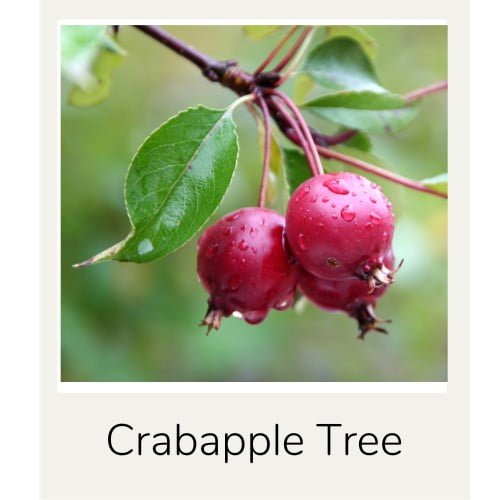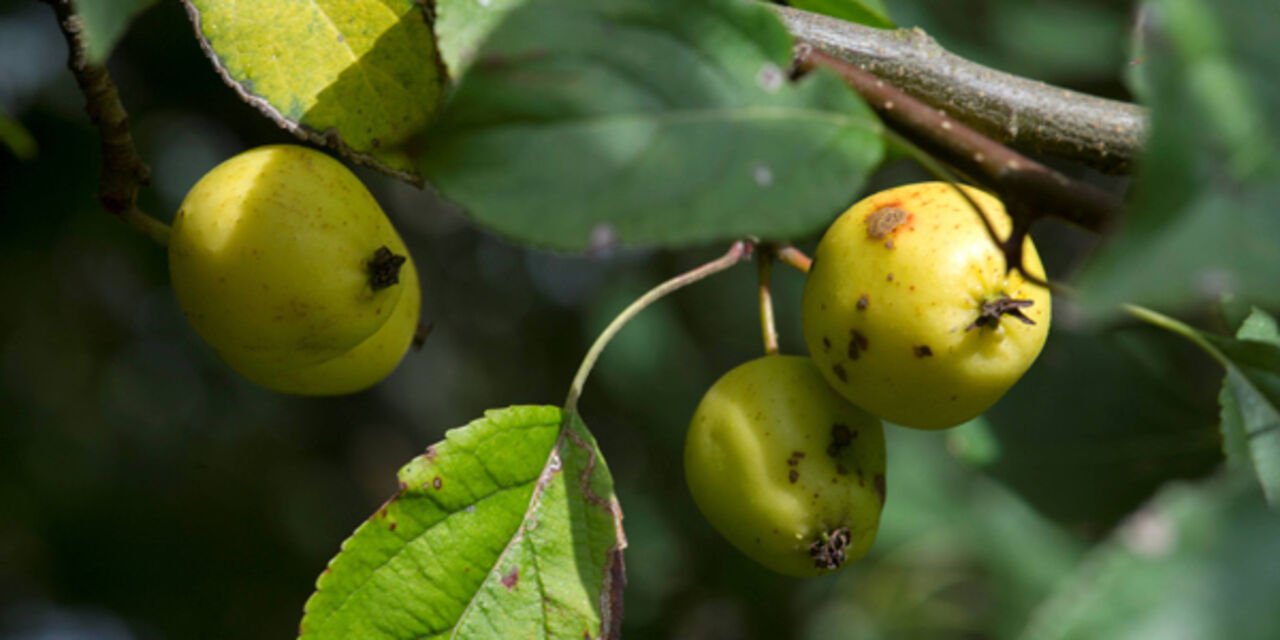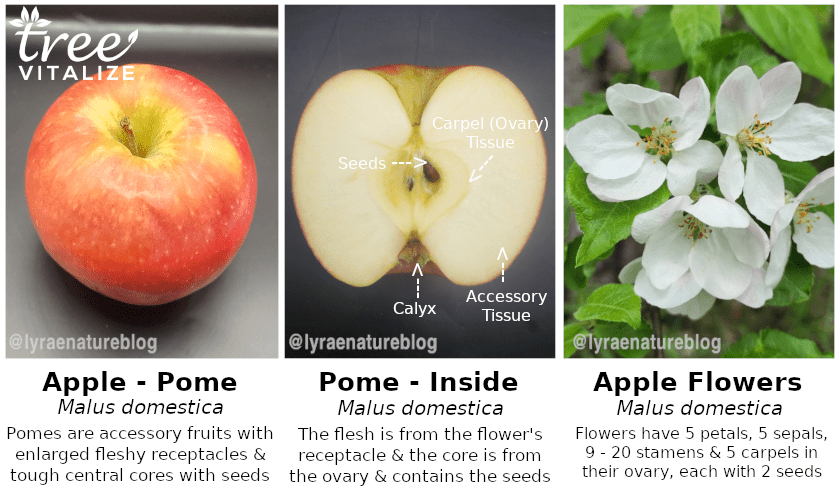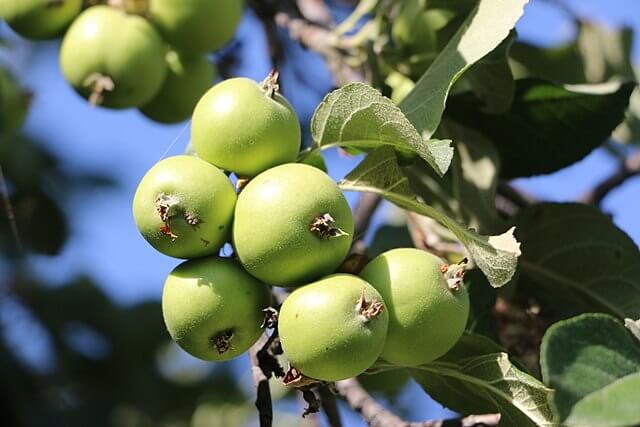Ready to discover the enchanting world of crab apples? In this article, you’ll delve into the intriguing characteristics of these petite fruits, learning about their size, color, flavor, and various uses. From their tangy taste to their vibrant hues, crab apples boast a unique allure that is sure to captivate your senses. So come along and embark on an exploration of these delightful gems – you’re in for a treat!

Types of Crab Apples
Crab Apple Varieties
Crab apples, also known by their scientific name Malus, are a diverse group of fruit-bearing trees that come in a wide range of varieties. Each variety has its own unique characteristics, including differences in size, shape, color, appearance, flavor, and taste. Some popular crab apple varieties include Dolgo, Centennial, Prairie Fire, and Snowdrift. These varieties offer a variety of options for gardeners and enthusiasts to choose from, ensuring that there is a crab apple that suits everyone’s preferences.
Size and Shape
Crab apple trees vary in size, typically ranging from 10 to 25 feet in height, depending on the variety. Some compact varieties, such as the Sargent crab apple, stay as small as 6 to 8 feet, making them suitable for smaller gardens or urban landscapes. In terms of shape, crab apple trees can have a rounded, spreading, or weeping form, adding an aesthetic appeal to any garden or landscape.
Color and Appearance
One of the most attractive features of crab apples is the vibrant and diverse colors they offer. The tree’s foliage can range from shades of green to red, providing a stunning array of colors throughout the year. When it comes to the fruit, crab apples come in various shades such as red, yellow, green, and even bi-colored varieties. The colorful fruits are often small – around 1 to 2 inches in diameter – but they make up for their size with their striking appearance.
Flavor and Taste
Crab apples are known for their tart and crisp taste. While they may not be as sweet as regular apples, they offer a unique flavor profile that is often described as tangy or slightly sour. This tartness makes crab apples perfect for culinary uses such as jams, jellies, and baking, where their flavor can add a delightful contrast to sweeter ingredients. Some varieties may have a more pleasant balance of sweetness and tartness, and tasting different varieties can be a fun experience for apple enthusiasts.
Growth and Habit
Tree Size
Crab apple trees are generally considered small to medium-sized trees. Depending on the specific variety, they can reach heights of 10 to 25 feet, with some dwarf varieties staying as small as 6 to 8 feet. Their manageable size makes them ideal for smaller gardens or adding ornamental value to landscapes. Additionally, their compact nature allows for easy maintenance, pruning, and harvesting.
Growth Rate
Crab apple trees are known for their moderate to fast growth rate. With proper care and favorable conditions, these trees can grow several feet in a year. However, it’s important to note that the growth rate may vary depending on the specific variety and environmental factors. Regular pruning and maintenance can help promote healthy growth and shape the tree according to your desired aesthetic.
Branching Structure
Crab apple trees generally have a well-branched structure, with branches spreading out and creating an appealing silhouette. The branching pattern can vary between varieties, with some having a more horizontal spread and others displaying a more upright growth habit. The branches often bear spines or thorns, which add to their ornamental value and provide protection for the tree against potential predators.
Shape and Form
The shape and form of crab apple trees can vary depending on the variety and growth habits. Some varieties have a rounded or oval shape, while others exhibit a more columnar or weeping form. These different shapes allow gardeners and landscapers to choose varieties that best suit their aesthetic preferences and the available space in their gardens or landscapes. The variety in shape and form adds visual interest and diversity to any setting.

Cultivation and Care
Soil Requirements
Crab apple trees are adaptable to a wide range of soil types, but they thrive best in well-drained soils. They prefer slightly acidic to neutral soil pH, ranging between 6.0 and 7.0. Good soil drainage is essential to prevent waterlogged conditions, which can lead to root rot. Before planting a crab apple tree, it is advisable to prepare the soil by incorporating organic matter, such as compost, to improve soil structure and fertility.
Sunlight and Temperature
Crab apple trees require full sun to thrive and produce ample flowers and fruits. They typically need a minimum of six to eight hours of direct sunlight per day. In terms of temperature, most crab apple varieties are hardy and can tolerate a wide range of climates. However, it’s important to choose varieties that are suitable for your specific region to ensure successful growth and fruiting.
Watering Needs
After planting, newly established crab apple trees need regular watering to promote root establishment and growth. Provide deep watering sessions, ensuring the soil is moist but not waterlogged. Once the tree is established, it becomes more tolerant of drought conditions. However, during prolonged dry periods, it is essential to provide supplemental irrigation to maintain tree health and productivity.
Pruning and Maintenance
Regular pruning is an important aspect of crab apple tree care. Pruning helps maintain the tree’s shape, remove dead or diseased branches, and promote airflow and sunlight penetration, reducing the risk of common diseases. It is best to prune crab apple trees during late winter or early spring while they are still dormant. Proper pruning techniques, such as making clean cuts and avoiding excessive pruning, will help ensure the tree’s health and vitality.
Blooming and Fruiting
Flower Characteristics
Crab apple trees are well-known for their stunning and abundant spring blooms. The flowers vary in color, ranging from white to pink and even deep red. They typically appear in clusters and create a gorgeous spectacle when the tree is in full bloom. The blossoms often attract pollinators, such as bees and butterflies, making crab apple trees a valuable addition to any garden or landscape for their ornamental value and their role in supporting local ecosystems.
Pollination and Fruiting
Most crab apple trees require cross-pollination with another compatible variety to produce fruit. This means that planting two or more different varieties in proximity is necessary for fruit set. Bees and other pollinators play a vital role in transferring pollen from one tree to another. When pollination is successful, the tree produces small, colorful fruits, which are often ornamental and provide a beautiful display of colors in the late summer and fall.
Fruit Development
After successful pollination, the small crab apple fruits begin to develop. The development process takes time, with fruits often starting small and green and gradually maturing into their final colors. The size and shape of the fruits can vary depending on the variety, but they are generally small and round with a firm texture. As the fruits ripen, they become softer and may change in color, offering a visual treat as they progress through different stages of maturity.
Harvesting Time
The harvesting time for crab apples generally occurs in late summer or early fall, depending on the variety and region. It’s important to assess the fruit’s readiness by checking its color, firmness, and taste. Ripe crab apples should have reached their desired color and firmness to indicate maturity. They should also possess the characteristic tartness and crispness associated with crab apples. Harvesting the fruits at the right time ensures the best flavor and quality for culinary uses or preserving.

Health Benefits
Nutritional Value
Crab apples offer several health benefits due to their rich nutritional content. They are low in calories and fat but packed with essential nutrients. These include vitamins C and A, which are known for their immune-boosting and antioxidant properties. Crab apples are also a good source of dietary fiber, which aids in digestion and helps maintain a healthy digestive system. Incorporating crab apples into your diet can be a tasty way to supplement your nutritional intake.
Antioxidant Properties
Crab apples are known to contain antioxidants, which play a crucial role in protecting the body against cellular damage caused by harmful free radicals. Antioxidants help neutralize these free radicals, reducing the risk of chronic diseases such as heart disease, cancer, and age-related disorders. Regular consumption of crab apples can contribute to overall well-being and support a healthy immune system.
Gastrointestinal Health
The dietary fiber present in crab apples promotes good gastrointestinal health. Fiber aids in digestion, prevents constipation, and helps maintain regular bowel movements. It also provides a feeling of fullness, making it beneficial for weight management. By incorporating crab apples into your diet, you can support a healthy digestive system and promote optimal gut health.
Weight Management
Crab apples can be a beneficial addition to a weight management or weight loss plan. Their low-calorie content and high fiber content make them a satisfying snack that can help curb hunger and reduce overall calorie intake. Additionally, the fiber in crab apples aids in digestion, promoting a feeling of fullness and helping regulate appetite. Including crab apples as part of a balanced diet can contribute to achieving and maintaining a healthy weight.
Traditional and Culinary Uses
Ornamental Purposes
Crab apples have been cultivated for centuries for their ornamental value. Their beautiful spring blossoms, vibrant foliage, and colorful fruits make them popular choices for landscaping and garden design. From small gardens to large parks, crab apple trees add a touch of natural beauty and elegance, enhancing the visual appeal of any outdoor space.
Preserving and Canning
Crab apples have long been used for preserving and canning purposes. Their firm texture and natural tartness make them ideal for creating flavorful jams, jellies, and preserves. The high pectin content in crab apples contributes to the setting process when making jams and jellies. Whether it’s a jar of homemade crab apple jelly or a delicious spread for toast, preserving crab apples allows you to enjoy their unique flavor year-round.
Baking and Cooking
Crab apples can add a delightful tang to various baked goods and culinary creations. They can be used in pies, tarts, cakes, and chutneys, providing a burst of flavor and a hint of tartness. Their small size makes them perfect for individual desserts or bite-sized treats. Experimenting with crab apples in your favorite baking recipes can elevate the taste and bring a touch of uniqueness to your culinary endeavors.
Jams and Jellies
The natural tartness of crab apples makes them a fantastic choice for making flavorful jams and jellies. Their high pectin content allows for a quick and successful gelling process. Whether you prefer a classic crab apple jelly or a creative combination with other fruits, such as crab apple and strawberry jam, these homemade preserves can be enjoyed on toast, as a topping, or as a sweet accompaniment to various dishes.

Crab Apples in History
Origins and Native Range
Crab apples have a rich history dating back thousands of years. They are believed to have originated in Central Asia and spread throughout Europe and Asia. In their native range, wild crab apples can still be found growing in forests and natural habitats. Over time, crab apples were cultivated and selectively bred for their desirable traits, leading to the wide variety of cultivated varieties we have today.
Cultural Significance
Throughout history, crab apples have held cultural significance in many societies and cultures. They have been associated with celebrations and festivals, symbolizing abundance, good luck, and fertility. In some cultures, crab apples were given as gifts or used as a decorative element during special occasions. Their beauty and symbolic meaning have made them an integral part of cultural traditions around the world.
Symbolism and Folklore
Crab apples have often been associated with symbolism and folklore in various cultures. In some traditions, they represent love, youth, and beauty. Additionally, they have been linked to wisdom and knowledge, serving as a reminder of the importance of learning and growth. Folklore tales often depict crab apples as magical or enchanted fruits, showcasing their mythical and symbolic qualities.
Medicinal Uses
Crab apples were historically used for their medicinal properties in traditional systems of medicine. Different parts of the tree, including the fruits, leaves, and bark, were believed to possess healing properties. They were used to alleviate digestive problems, boost immunity, and treat various ailments. While their medicinal use has diminished in modern times, crab apples still hold a place in herbal traditions and folk remedies.
Pest and Disease Management
Common Pests
Crab apples, like other fruit trees, can be susceptible to certain pests. Some common pests that may affect crab apple trees include aphids, spider mites, caterpillars, and scale insects. Regular monitoring and prompt action can help control these pests. Organic pest control methods, such as insecticidal soaps or horticultural oils, can be employed to minimize the impact of pests while maintaining a healthy environment.
Fungal Diseases
Crab apple trees may be prone to certain fungal diseases, including apple scab, fire blight, and cedar apple rust. These diseases can affect the tree’s foliage, flowers, and fruits, impacting its overall health and appearance. Regular inspection and proper cultural practices, such as removing infected plant material and providing adequate air circulation, can help prevent and manage fungal diseases. In severe cases, appropriate fungicides may be used in consultation with a gardening professional.
Integrated Pest Management
Integrated Pest Management (IPM) is a holistic approach to pest control that aims to minimize the impact of pests and diseases while minimizing the use of synthetic pesticides. IPM involves regular monitoring, proper sanitation, cultural practices, and, if necessary, the use of biological controls or targeted application of pesticides. By adopting IPM practices, gardeners can maintain a healthy balance between pests, diseases, and beneficial organisms, ensuring the overall well-being of the crab apple trees.
Preventive Measures
Prevention is the key to managing pests and diseases effectively. Providing good cultural care, such as proper watering, fertilization, and pruning, can help keep crab apple trees healthy and resilient to potential pests and diseases. Properly disposing of fallen leaves, fruits, and pruned branches can also reduce the risk of pests and diseases overwintering and affecting the tree’s health. Regular observation and early intervention are essential in preventing pest and disease outbreaks.

Crab Apples in Landscaping
Garden Design
Crab apple trees are highly valued by garden designers for their ornamental qualities. Their beautiful spring blossoms, colorful fruits, and attractive foliage add visual interest and enchantment to any garden design. The wide variety of sizes, shapes, and colors available in crab apple varieties allows for flexibility in designing landscapes, whether it’s incorporating them as focal points, hedges, or creating stunning color palettes.
Pollinator Attraction
Crab apple trees are excellent attractors of pollinators, such as bees and butterflies. Their colorful and fragrant spring blossoms serve as an abundant source of nectar and pollen, supporting the health and diversity of local pollinator populations. By planting crab apples in your garden, you can contribute to the conservation of these vital insect species while enjoying their mesmerizing beauty and the buzzing activity they bring to your outdoor space.
Fall Colors
In addition to their spring blooms and colorful fruits, crab apple trees offer a stunning display of fall colors. As the weather cools and the days shorten, the foliage of crab apple trees transforms into vibrant shades of red, orange, yellow, and even purple. The stunning autumn hues can bring warmth and visual impact to any landscape, creating a captivating backdrop for the changing seasons.
Wildlife Benefits
Crab apple trees provide significant benefits to wildlife and can help create an ecologically diverse garden. The fruits of crab apple trees are a valuable food source for birds, who rely on them for sustenance during the colder months when other food sources may be scarce. The tree’s dense branching structure also provides shelter and nesting sites for various bird species. By planting crab apples, you can provide a habitat and food source for local wildlife, fostering biodiversity in your garden.
Propagation and Growing from Seed
Seed Collecting and Treatment
Propagating crab apple trees from seed can be an exciting and rewarding process. To collect seeds, allow the fruits to fully ripen on the tree before harvesting. Remove the seeds from the fruit, wash off any pulp or residue, and allow them to dry naturally. Cold stratification, which involves exposing the seeds to a period of chilling, can help break their dormancy and improve germination rates. This can be achieved by placing the seeds in a moistened paper towel and refrigerating them for several weeks.
Germination Methods
Once the seeds have undergone the cold stratification process, they can be sown in well-draining potting soil or seed-starting mix. Plant the seeds at a depth of about ¼ inch and keep the soil moist but not waterlogged. Place the container in a warm location or use bottom heat to aid germination. Germination can take several weeks to a few months, so patience is key. Once the seedlings have developed, they can be transplanted into larger pots or directly into the ground.
Transplanting and Care
When transplanting crab apple seedlings, choose a sunny location with well-drained soil. Prepare the planting hole by loosening the soil and incorporating organic matter. Carefully remove the seedling from its pot, making sure to disturb the roots as little as possible. Place the seedling in the hole and backfill with soil, firming it gently around the roots. Water the plant thoroughly after transplanting and continue to provide regular watering until it becomes established.
Timeframe for Growth
From seed to a mature flowering crab apple tree, the timeframe for growth can vary depending on several factors, including the specific variety, environmental conditions, and cultural care. On average, it can take anywhere from 5 to 8 years for a crab apple tree grown from seed to reach maturity and begin flowering. It’s important to note that growing trees from seed can introduce genetic variability, resulting in variations in tree size, shape, and fruit characteristics compared to the parent tree.
In conclusion, crab apples are a diverse and fascinating group of trees that offer a range of benefits for gardeners, enthusiasts, and nature lovers alike. From their stunning spring blooms to their vibrant fall colors, the unique characteristics of crab apples make them a valuable addition to any garden or landscape. Whether you are interested in their culinary uses, their ornamental appeal, or their historical and cultural significance, crab apples are sure to impress with their beauty, flavor, and symbolism. With proper care and attention, you can enjoy the many wonders of crab apple trees in your own outdoor space.



